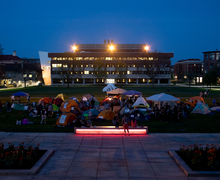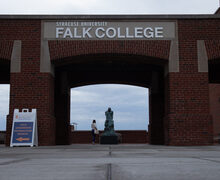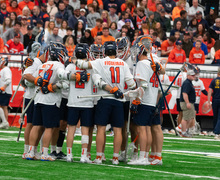Students paint over racist graffiti found in art facility
Diana Riojas | Feature Editor
Students and professors of the School of Art paint a mural over the racial-bias graffiti that was reported on Tuesday morning.
By Jessica Oh’s feet was a black spray paint bottle and in front of her eyes was the racist graffiti that brought her to tears. Oh was simply on her way to class.
It was about 8 a.m. inside Syracuse University’s Comstock Art Facility on Tuesday. Oh, a senior, witnessed one of the at least 16 hate crimes and bias-related incidents reported on or near campus.
She reported the incident and an officer from the Department of Public Safety arrived. But Oh grew uneasy by the officer’s questions, asking her where she was the night before and if she really wanted the graffiti to be reported as racist.
“DPS asked for my ID instead of asking me if I was okay first,” Oh said.
Soon, the racist graffiti toward Asian people would be covered. It didn’t take long for SU’s art community to transform the wall. School of Art students and professors worked on Thursday afternoon to paint over the graffiti.
SU freshman Nya Fitzgerald was the first to arrive. She could see the fresh, off-white sheen of paint where the graffiti used be and began outlining. Others would follow moments later.

Jessica Oh would report the graffiti on Tuesday morning but DPS would send a campus-wide email about the incident almost two days later. Diana Riojas | Feature Editor
What first began as a rough sketch of a circle turned into a fist squeezing the juice of an orange. Around it, were the words “SU UNITED,” an orange and yellow colored peace sign, and former first lady Michelle Obama’s motto: “When they go low, we go high.”
Playing in the background were the early 2000s hits. Lady Gaga’s “Telephone,” had a group of students discussing Gaga’s glory days. Soon, students would hit their rhythm, churning out the key elements of the mural in less than two hours.
Professor Deborah Dohne had an inkling that the project would be more impromptu than other mural projects she worked on. After hearing about the graffiti, she asked her Tuesday class whether they should do anything to the wall. Freshman Rayna Schiering then suggested they should paint a mural over it.
Dohne didn’t expect a large turnout but wanted to give students an opportunity to come together and paint. She believes if students are with one another, it’s more beneficial than being alone in a dorm.
Schiering said she was shaken by the string of hate crimes on campus in the last few weeks, but always knew she wanted to play a role in promoting inclusivity. She wanted to assist in any way she could.
The saying, “SU UNITED,” is like a “silent F U,” to whoever was responsible for the graffiti, she said, but the mural also acts as a means of fighting back hatred. Framing the mural are multicolor hearts, fall leaves, swirls and music notes.
D’Mya Curtis, a freshman at SU, said she “felt a little down,” prior to the painting and had minimal energy to do anything. But during the process, she felt empowered. In the first few hours of the mural, Curtis painted two naturalistic sunflowers.
“It’s not much, but I think the sunflower represents happiness and peace,” she said.
Using a photo from her phone as a reference, School of Art Director Joanna Spitzner painted her cat on the wall. Though the day was filled with students coming together, Spitzner was also thinking about how to maintain the safety of the Comstock community without a strong presence of DPS surveillance.
When the graffiti was reported, Spitzner called DPS multiple times before someone answered, Oh said. Soon after DPS arrived, Spitzner intervened as the officer continued to repeat the same questions to Oh.
It would be two days before DPS would report the incident in a campus-wide email.
Now, Spitzner wishes for SU to help find a way to keep students safe inside the facility without the need to have DPS as a constant presence on-sight. After the incidents, students now must swipe into the building, 24/7, a shift from the regular 8 p.m. protocol.
“I think policing has a role, but I don’t think that would solve everything,” said Spitzner. “It really is like a home here for people.”
She added that faculty members continue to discuss what they can do now to make students feel as safe as possible.
For Dohne, the mural was the first positive experience from how the last two weeks unfolded. She sees her students laughing and bonding and it brings herself to smile.
“I hope – what I really hope – they walk away feeling a little bit better before they started doing this,” she said.
Published on November 22, 2019 at 1:17 pm
Contact Diana: [email protected]




